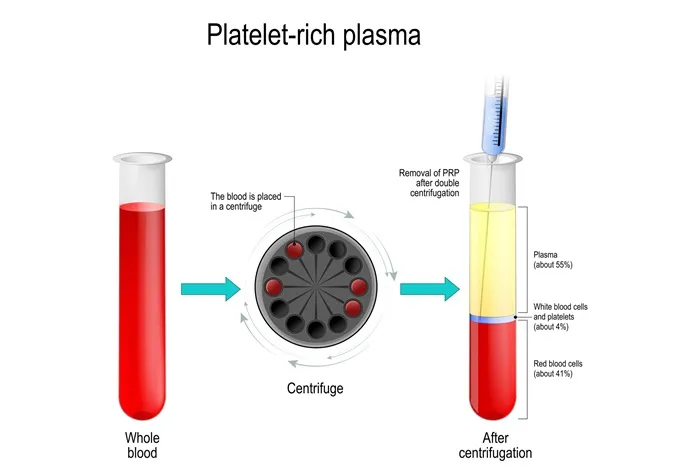Platelet-Rich Plasma (PRP) therapy has emerged as a promising and non-invasive treatment option for hair restoration, particularly for individuals experiencing androgenetic alopecia (male and female pattern baldness). PRP involves the use of a patient’s own blood to stimulate hair growth and improve hair density. This article will provide a comprehensive overview of PRP, its mechanism of action, success rates, and how it can be integrated into hair restoration treatment plans.
Understanding PRP Therapy
What Is PRP?
PRP is a concentration of platelets derived from a patient’s own blood. These platelets are rich in growth factors and cytokines, which are proteins that play a crucial role in cell repair and tissue regeneration. When injected into the scalp, PRP can stimulate dormant hair follicles, promote hair growth, and improve overall hair health.
How Does PRP Work?
Stimulating Hair Follicle Growth
PRP works by stimulating the hair follicles at the cellular level. The growth factors in PRP bind to receptors on the surface of follicular cells, triggering a series of biochemical reactions that promote cell growth, proliferation, and differentiation. This can lead to an increase in the size and activity of the hair follicles, resulting in thicker and healthier hair.
Prolonging the Anagen Phase
The anagen phase is the active growth phase of the hair follicles. PRP can help prolong this phase, increasing the length of time the hair follicles are actively producing hair. This can lead to longer and more abundant hair growth.
Improving Blood Circulation
As mentioned earlier, VEGF in PRP promotes angiogenesis, which improves blood circulation to the hair follicles. A better blood supply ensures that the follicles receive an adequate supply of oxygen and nutrients, which are essential for their normal functioning and growth.
Clinical Studies on PRP Success
Recent studies have shown promising results for PRP therapy in hair restoration. For instance, a review of 12 clinical trials found that PRP therapy yielded significant improvements in hair density and thickness in 84% of the studies. Another study reported that patients with androgenetic alopecia who received PRP injections experienced a significant increase in hair density within six weeks.
Patient-Reported Outcomes
Patients undergoing PRP therapy often report these.
- Increased hair density and thickness
- Enhanced self-esteem and confidence
- A noticeable reduction in hair shedding
Factors Influencing PRP Success
Patient Age and Health
The effectiveness of PRP therapy can vary based on a patient’s age and overall health. Younger patients with fewer health issues tend to respond better to treatment. Overall health, including nutrition and lifestyle, plays a significant role in the success of PRP therapy.
Type of Hair Loss Condition
Different types of hair loss respond differently to PRP therapy. PRP has been shown to be effective for androgenetic alopecia and alopecia areata, but results can vary based on the severity and type of hair loss.
Frequency and Number of Sessions
The success of PRP treatment is also influenced by the frequency and number of sessions. Most patients require 3 to 4 sessions, spaced 4 to 6 weeks apart, to achieve optimal results. Maintenance sessions every 6 to 12 months are recommended for continued hair growth and results.
Integrating PRP with Other Treatments
PRP can be used as a standalone treatment or in combination with other hair restoration methods, such as minoxidil and finasteride. Studies have shown that combining PRP with these medications can enhance the effectiveness of hair restoration.
Factors to Consider Before Opting for PRP Therapy
Cost
PRP therapy can be relatively expensive, especially when multiple sessions are required. The cost may vary depending on the location, the clinic, and the specific treatment protocol. Patients should consider their budget and weigh the cost against the potential benefits of the treatment.
Side Effects and Risks
While PRP is generally considered a safe treatment, it is not without risks. Some patients may experience mild side effects such as pain, swelling, or bruising at the injection site. In rare cases, there may be an allergic reaction or an infection. It’s important to discuss these potential risks with a qualified healthcare provider before undergoing PRP therapy.
Provider Qualifications
The success of PRP therapy depends to a large extent on the qualifications and experience of the provider. It’s crucial to choose a qualified and experienced doctor or healthcare provider who is well – versed in the use of PRP in hair restoration. The provider should be able to assess your condition accurately, develop an appropriate treatment plan, and perform the procedures safely and effectively.
Conclusion
PRP therapy offers a promising and non-invasive option for hair restoration, with a success rate that often exceeds 80%. The treatment leverages the body’s own healing properties to stimulate hair growth and improve hair density. While individual responses may vary, PRP has been shown to be effective for various types of hair loss, particularly androgenetic alopecia. By understanding the factors influencing PRP success and following a consistent treatment plan, patients can achieve significant improvements in hair health and appearance.
Related topics:
- The Cost of PRP for Hair Loss: A Comprehensive Guide
- How Much Effective Is PRP for Hair Loss: What You Need To Know
- Blood Pressure Medications & Hair Loss: Is There a Connection?


